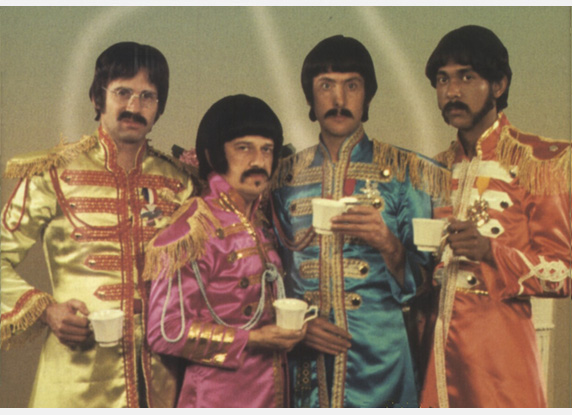Rutles Update!
Subject: RUTLES UPDATE!! From: murcura@aol.com (Murcura) Date: 11 Apr 1996 11:17:58 -0400 With all the hoopla over "The Beatles Anthology," many have wondered, "Whatever happened to The Rutles after THEIR split?" Well, wonder no more: LET'S BE NATURAL: THE RUTLES AFTER THE BREAKUP When the Rutles broke up in 1970, many fans wondered if the Prefab Four could make it on their own. After all, the rush of Rutlemania had taken its toll on Dirk, Nasty, Stig, and Barry -- and none of them seemed able to duplicate the legendary Rutland sound on their own. Dirk McQuickly came the closest. When his first solo album, "McQuickly," was released, fans didn't know what to make of "The Cute One." Was he to be reviled because he broke up the Rutles, or merely because his own album was o bad? After three even worse LPs, Dirk formed The Punk Floyd and hit it big with "Band In The Rut," released in 1973. He then spent the next 20 years putting out catchy, Rutlesque music that absolutely no one ever listened to. His only other major success was 1982's "Tug McGraw," a strangely compelling concept album about the life of the Philadelphia Phillies baseball player. Ron Nasty, as usual, took a more unusual path. After the brilliant "Ron Nasty/Plastic Chastity Band" LP of 1970 (which included "Rod," a bitter rejection of Rod Stewart, table-tapping, and the Rutles), Nasty and Chastity moved to America to be closer to the burgeoning Neo-Nazi movement. In between rallys, Nasty found time to write "How Do You Eat?", a vicious swipe at Dirk's recent dental woes. After 1974's "Ruts And Ridges" album, Nasty retired from music for five years. Then, on the verge of a comeback in 1980, he suddenly abandoned showbiz and moved with Chastity to East Germany so she could re-discover her roots and practice her peculiar brand of Destructo Art. The spectacular "Fall of the Berlin Wall" was considered her greatest piece, and Germany has yet to recover from its debut. Stig O'Hara, already pegged as The Quiet Rutle, has been nearly invisible since the breakup of the group. Despite the worldwide success of his first solo single, "My Sweet Lard," he has only worked intermittently, causing periodic outbreaks of the "Stig Is Really Dead This Time" rumor. Solo triumphs for Stig include the self-titled "Stig O'Hara" (1979), "Somewhere In Rutland" (1981), and "Cloud Mine" (1987). Stig also gained notoriety in the late- Eighties for his role in the rock supergroup The Sniveling Dingleberries. Barry Wom (real name: Barrington Womble) took the breakup of the Rutles the hardest. A superstar drummer with no discernable talent, he retreated from the public eye during the early Seventies, content to live off the residuals from his solo hit, "When You Find The Girl Of Your Dreams In The Arms Of Some Scotsmen From Hull." After a brief stint as two hairdressers, he reverted to the wild life until the early Nineties when he finally kicked his addiction to kitchen spices, inspiring him to release a strong comeback album, "Thyme Takes Thyme." In 1994, the reunion nobody wanted took place anyway. Dirk, armed with a demo tape of Nasty's (who wanted no part of it), persuaded Stig and Barry to reform for one last hurrah. The song, "Me As A Turd," was a typically revealing piece of self-criticism written by Nasty just before his defection to the Eastern Bloc. After being reworked by the remaining Rutles, it was included as part of "The Rutles Anthology," a 27-part TV series celebrating the group. Unfortunately, however, no one in England seemed to remember the Rutles, and the series was a financial disaster, ultimately forcing the BBC out of business and leading to the divorce of Prince Charles and Princess Diana. In a statement released by Rutle Corps., group spokesman Eric Manchester remarked, "It is marvellous to see that the Rutles can still have such an impact on British culture." (c)1996 by Sean Murdock and Leggy Mountbatten
|
|
|

